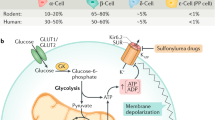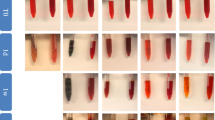Abstract
BIOSYNTHETIC studies with human islet cell tumours1,2, rat2,3 and codfish4 islets, and foetal calf pancreas5 have shown that insulin is formed from proinsulin, a single-chain polypeptide precursor. This protein has subsequently been purified from commercial preparations of crystalline insulin6, and the amino-acid sequences of porcine7 and bovine8 proinsulin have been determined. The molecule begins at the N-terminus with the B-chain sequence of insulin, terminates with the insulin A-chain and bears a connecting segment of thirty (bovine) or thirty-three (porcine) amino-acids linking the two chains. Although 30 per cent of the amino-acid sequences of these connecting segments differ, identical pairs of basic amino-acids occur at each end in both species. Limited tryptic digestion in each case liberates desalanyl–insulin, alanyl–arginine, free arginine and the remainder of the connecting segment as an intact peptide6,7.
This is a preview of subscription content, access via your institution
Access options
Subscribe to this journal
Receive 51 print issues and online access
$199.00 per year
only $3.90 per issue
Buy this article
- Purchase on Springer Link
- Instant access to full article PDF
Prices may be subject to local taxes which are calculated during checkout
Similar content being viewed by others
References
Steiner, D. F., and Oyer, P. E., Proc. US Nat. Acad. Sci., 57, 473 (1967).
Steiner, D. F., Cunningham, D., Spigelman, L., and Aten, B., Science, 157, 697 (1967).
Clark, J. L., and Steiner, D. F., Proc. US Nat. Acad. Sci., 62, 278 (1969).
Grant, P. T., and Reid, K. B. M., Biochem. J., 110, 281 (1968).
Tung, A. K., and Yip, C. C., Diabetologia, 4, 68 (1968).
Steiner, D. F., Hallund, O., Rubenstein, A. H., Cho, S., and Bayliss, C., Diabetes, 17, 725 (1968).
Chance, R. E., Ellis, E. M., and Bromer, W. W., Science, 161, 165 (1968).
Steiner, D. F., Clark, J. L., Nolan, C., Rubenstein, A. H., Margoliash, E., Aten, B., and Oyer, P. E., Recent Progress in Hormone Research, 25, 207 (Academic Press, New York, 1969).
Clark, J. L., Cho, S., Rubenstein, A. H., and Steiner, D. F., Biochem. Biophys. Res. Commun., 35, 456 (1969).
Davoren, P. R., Biochim. Biophys. Acta, 63, 150 (1962).
Rubenstein, A. H., Steiner, D. F., Cho, S., Lawrence, A. M., and Kirsteins, L., Diabetes, 18, 598 (1969).
Morgan, C. R., and Lazarow, A., Diabetes, 12, 115 (1963).
Rubenstein, A. H., Cho, S., and Steiner, D. F., Lancet, i, 353 (1965).
Author information
Authors and Affiliations
Rights and permissions
About this article
Cite this article
RUBENSTEIN, A., CLARK, J., MELANI, F. et al. Secretion of Proinsulin C-Peptide by Pancreatic β Cells and its Circulation in Blood. Nature 224, 697–699 (1969). https://doi.org/10.1038/224697a0
Received:
Revised:
Issue Date:
DOI: https://doi.org/10.1038/224697a0
This article is cited by
-
Biological activity versus physiological function of proinsulin C-peptide
Cellular and Molecular Life Sciences (2021)
-
Energetic management in wild chimpanzees (Pan troglodytes verus) in Taï National Park, Côte d’Ivoire
Behavioral Ecology and Sociobiology (2021)
-
Ultrafiltration binding analyses of glycated albumin with a 3D-printed syringe attachment
Analytical and Bioanalytical Chemistry (2018)
-
The role of cullin 5-containing ubiquitin ligases
Cell Division (2016)
-
Mate-guarding constrains feeding activity but not energetic status of wild male long-tailed macaques (Macaca fascicularis)
Behavioral Ecology and Sociobiology (2014)
Comments
By submitting a comment you agree to abide by our Terms and Community Guidelines. If you find something abusive or that does not comply with our terms or guidelines please flag it as inappropriate.



